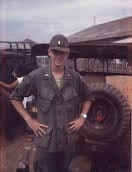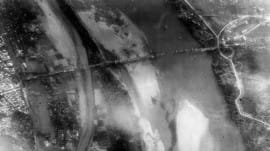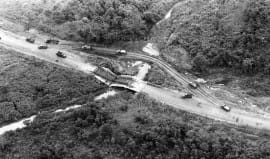December 18, 2015 Life In A Jungle Basecamp
 We arrived at Tan Son Nhut air base in March 1967 on a chartered commercial airliner. We stepped off the plane on a pitch-dark night into what seemed like a hot wet blanket. We had flown for 14 hours and were very jet lagged due to the 12-hour time zone difference from home. After a day of processing at the Long Binh replacement center, I was transported to my unit, the Aerial Surveillance Unit of the 9th Infantry Division headquarters at Bearcat, located about 25 miles northeast of Saigon.
We arrived at Tan Son Nhut air base in March 1967 on a chartered commercial airliner. We stepped off the plane on a pitch-dark night into what seemed like a hot wet blanket. We had flown for 14 hours and were very jet lagged due to the 12-hour time zone difference from home. After a day of processing at the Long Binh replacement center, I was transported to my unit, the Aerial Surveillance Unit of the 9th Infantry Division headquarters at Bearcat, located about 25 miles northeast of Saigon.
Bearcat was a base camp for two battalions of infantry and several support units. It was a rectangular shaped tent city surrounded by 10-foot high earth berms with machine gun entrenchments every 100 yards. The berms were about ½ mile by ¼ mile long and had been built by Army engineers who bulldozed a large clearing in the middle of a jungle. Artillery batteries occupied two opposing corners, and we soon learned the difference between the sound of friendly outgoing artillery fire and incoming Viet Cong mortar rounds. On several nights we would be roused from sleep to head to our protective underground bunkers.
Life at Bearcat was not particularly pleasant, but I was happy to be stationed near the division commanding general and felt reasonably safe. We worked 6 days a week, 12 hours per day and had Sunday off. We lived in GP Medium Olive Drab tents that accommodated 6 bunks set on a floor of shipping pallets to keep us out of the mud during the six-month rainy season. The pallets also served as walkways to the mess hall and our community shower. The tents kept us dry at night but were too hot to be in during the day. The food was OK, but most days we were longing for a normal, solid bowel movement. The smell of burning shit was everywhere, as that was the preferred method of dealing with our outhouse latrine waste.

Aerial shot of the Paul Doumer Bridge after it had been destroyed.
My workday consisted of supervising a group of 15 men who studied aerial photography that had been ordered by our boss, the Division G-2, for surveillance of areas of suspected enemy activity. The men used stereoscopes to get 3-D images. They would identify enemy bunkers, bridges that had been blown, new trails in the jungle, etc. We would then update maps with this information and provide them to the company commanders who were conducting search and destroy missions. We also gathered intelligence reports from other sources such as POW interrogations and radio intercepts and would update the maps with this data as well.The company commanders would also request recent photos of helicopter landing zones for their upcoming missions. We accommodated them by shooting pictures with a hand held 70 mm camera from a small observation helicopter.

South Vietnamese supply trucks take a detour around a destroyed bridge.
My unit also participated in “people sniffer” missions. The Army had a device that was supposed to be able detect the odor of large groups of humans as they perspired in the jungle. Unfortunately, it also detected smoke. The probe of the people sniffer was mounted on the front skid of a Huey helicopter and a technician passenger monitored the instrument screen for positive readings. At treetop level, the copter flew back and forth in 0.5-kilometer passes over a predetermined area of suspected enemy activity. When he had a positive reading, the technician radioed the reading to one of my personnel who was flying at 1500 feet above in a single engine observation plane and tracking the copter’s location. My guy would mark the reading on the map only if it was not just smoke or a friendly village. He would then radio the coordinates to the artillery branch who would shell the area. I chose to ride in the Huey during two of these missions. It was quite a thrill to be soaring over the trees at 125 mph.
At the end of my Vietnam tour, I was awarded the Bronze Star for meritorious service. I flew home in January 1968, ten days before the Tet offensive was launched by the Viet Cong.
Also read JAI director Tracy Metz’s introduction (December 2), editor Phillip C. Schaefer’s introduction (December 4), the essay by veteran Jim Harris (December 7), the essay by veteran Glen Kendall (December 9), the essay by Karl F. Winkler (December 14), and the essay by George J. Fesus (December 16), the essay by James Laughlin (December 21), the essay by John T. Lane (December 23), and the essay by Bud McGrath (December 27).